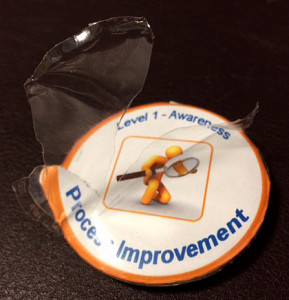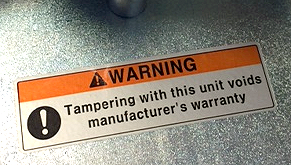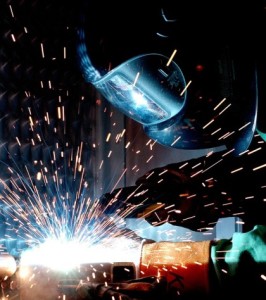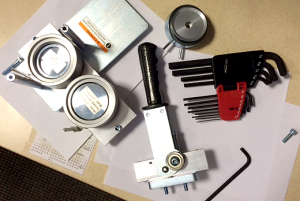A Low-Tech Photo-Essay Fever Dream
I broke the buttonmaker. This statement is not poetry or metaphor. “The buttonmaker” is not slang that the kids say these days. The buttonmaker is a real, literal thing. And I literally broke it.
The buttonmaker is not a system, an application, or a new type of server. It is not a dashboard or reporting tool in Epic. The buttonmaker is not a curve-jumping, paradigm-shifting, SQL-based, performance-optimized way to buy dog food on the cloud.
The buttonmaker is a machine. It makes buttons. It is an old school low-tech device that creates buttons. The kind of buttons you have to wear at a conference, or if you work at Applebee’s. But then I broke it, and it no longer made buttons.
 The buttonmaker is an imposing entity. It has heft. Its weight is awkwardly distributed. And yet it is a precisely engineered machine. It demands respect and prompts more than a little fear. As you can see here, it is made of cast iron, stainless steel, and probably three other obscure materials known only to professional European metallurgists. Its cold surfaces gleam with futuristic light. It’s easy to get lulled into a false sense that the buttonmaker is impervious to all. And yet it was randomly broken by the normal workings of one dumb man.
The buttonmaker is an imposing entity. It has heft. Its weight is awkwardly distributed. And yet it is a precisely engineered machine. It demands respect and prompts more than a little fear. As you can see here, it is made of cast iron, stainless steel, and probably three other obscure materials known only to professional European metallurgists. Its cold surfaces gleam with futuristic light. It’s easy to get lulled into a false sense that the buttonmaker is impervious to all. And yet it was randomly broken by the normal workings of one dumb man.
When it first arrived at the PMO a few weeks ago, I read the buttonmaker’s reference guide with all due seriousness. The manufacturer’s website also includes a video demonstrating its correct use. I watched that video roughly 7 billion times, give or take. Once you get all the button components prepped, it’s actually a pretty simple process to make a button. There are no variables to the process. The top half of the button with your graphic gets sandwiched between a transparent mylar cover and a tin backing piece. That all goes into the left cylinder.  You crank the black handle making an industrial CA-CHUNK noise that you feel as well as hear. Then a backing piece with the pin (that lets you pin the button to your Applebee’s uniform) is set in the right cylinder, which then slides over to the left, under the handle, and its crank, CA-CHUNK again. The button is made. You are now a successful buttonmaker and you update your LinkedIn profile accordingly.
You crank the black handle making an industrial CA-CHUNK noise that you feel as well as hear. Then a backing piece with the pin (that lets you pin the button to your Applebee’s uniform) is set in the right cylinder, which then slides over to the left, under the handle, and its crank, CA-CHUNK again. The button is made. You are now a successful buttonmaker and you update your LinkedIn profile accordingly.
It all played out this way for my first two or three button-making sessions. One time I accidentally put two mylar sheaths in the 1st cylinder sandwich, which is easy to do because they are microscopically thin. The buttonmaker did not like that, and it let me know. The crank handle sputtered and stalled ¾ of the way down. Expressing its disapproval, it spat out the offending proto-button upon retracting the handle. “Lesson learned” as we say in the project management business.
But this past Monday, disaster stuck. I was five buttons into what I imagined was my shift at the button-making factory. Button #6 seemed fine initially. The 2nd CA-CHUNK of the handle was normal. However, no button subsequently emerged in the right cylinder. Upon inspection, I saw a twisted half-button dangling under the crank handle mechanism. Tugging at it gently, I found that it held firm. A second more vigorous attempt split the mylar awkwardly.
This was a moment of crisis. The manufacturers of the buttonmaker provide a trouble-shooting tip sheet, but it did not cover this scenario. I upended the buttonmaker to get a better look. The gangly abomination I had created rattled noisily. It was wedged in there good. The obvious temptation (which is usually never a good idea) is to yank that sucker out of there with brute force. Which I did. You can see what emerged:
 There was still ragged mylar sheathing up in the buttonmaker’s undercarriage. At this point in the story, I should mention the many stark warnings issued by the manufacturer about “tampering with the buttonmaker”. Don’t do it, man. Just don’t.
There was still ragged mylar sheathing up in the buttonmaker’s undercarriage. At this point in the story, I should mention the many stark warnings issued by the manufacturer about “tampering with the buttonmaker”. Don’t do it, man. Just don’t. 
It was time to concede I had reached the limits of my ability to manage this crisis (lesson learned: quitters sometimes win). Looking at their website, I learned the manufacturer was based not in Zurich as I had fever-dreamt, but in Iowa. A good sign. I had escaped the judgment of Swiss engineers, which I feared mightily. No, instead I got Brian the Iowan (I swear I’m not making this up) from the buttonmaker’s help desk. Our chat went like this:
Brian: First you’re going need to get out your Allen wrenches.
Me: But I’m at work, I don’t have any Allen wrenches. I work in a cube, like in an office.
Brian: You’re going to need a set of Allen wrenches.
Me: Ok, I have some at home. I’ll bring them in tomorrow. Can I call you…
Brian: No, I’m busy tomorrow. Just write this down and do it when you have Allen wrenches.
Me: But what about the tampering warning. I don’t want to fly solo and do something unsanctioned.
After about 20 seconds where Brian seemed to be silently sizing me up as the biggest goof on earth, he gave me step by step directions on how to fix the buttonmaker. I wrote them down, while thinking I’d rather be talking with the Swiss.
The next day, with my Allen wrenches, I embarked on my Tolkien-esque journey to fix the buttonmaker. A depiction of the process is illustrated below:
And of all things, it worked. I fixed the buttonmaker. In reality, I suppose I did not really break the buttonmaker to begin with. Without warning or cause, I fell victim to the buttonmaker’s vague industrial whims. Occasionally mysterious are the ways of the buttonmaker. As Brian the Iowan explained to me when I asked if I had done something wrong, “these things just happen sometimes.”




Hilarious!!
Thanks, David 🙂